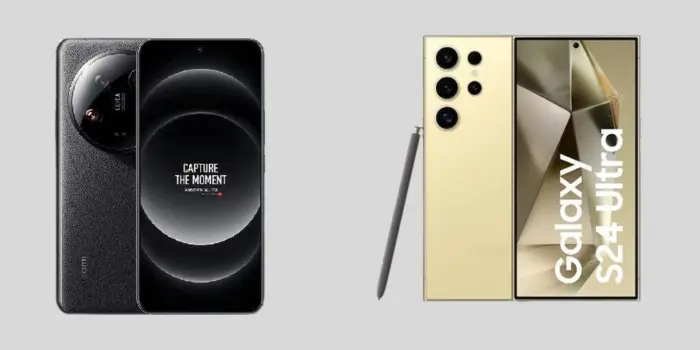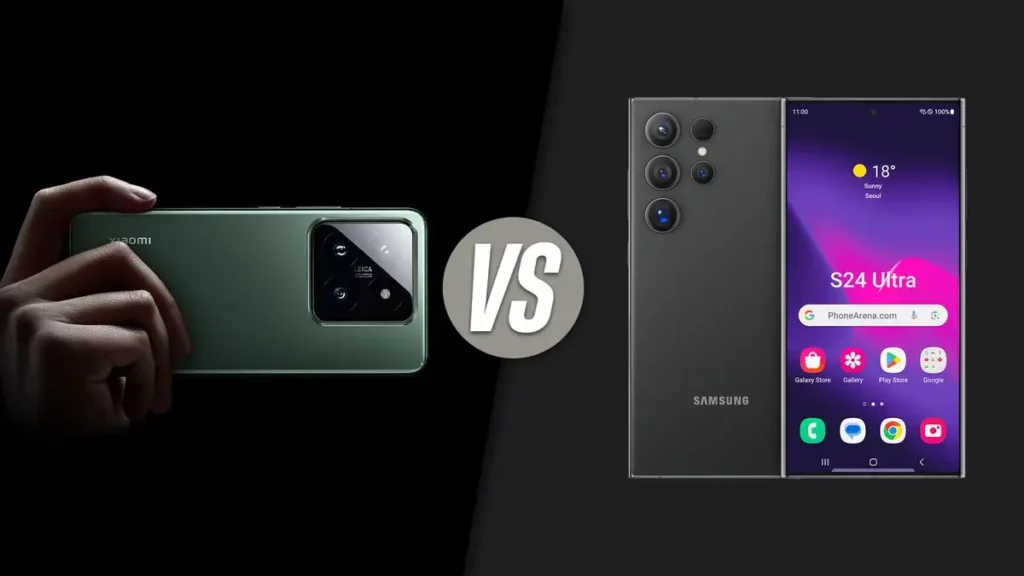The smartphone landscape is constantly evolving, with manufacturers pushing the boundaries of innovation to deliver the most powerful and feature-rich devices.
In the premium segment, the upcoming Xiaomi 14 Ultra and Samsung Galaxy S24 Ultra are poised to be the next big contenders, igniting a very strong battle for consumer loyalty.
This article delves into a detailed comparison of Xiaomi 14 Ultra vs Samsung Galaxy S24 Ultra dissecting their strengths and weaknesses across various aspects to help you decide which “giant” reigns supreme for your needs.
Introduction
The Xiaomi 14 Ultra and Samsung Galaxy S24 Ultra represent the pinnacle of smartphone technology, offering cutting-edge features, exceptional performance, and premium design.
Both phones cater to the most demanding users, with powerful processors, impressive camera systems, and long-lasting batteries.
This article aims to provide a comprehensive comparison of these two flagship devices, analyzing their key specifications, user experience, and potential strengths and weaknesses to help you make an informed decision when choosing your next smartphone.
Design and Display

Both phones offer a premium design but with distinct aesthetics.
- Xiaomi 14 Ultra: Maintains a minimalist approach with a sleek, ceramic back and a centered punch-hole camera for a near bezel-less display.
- Samsung Galaxy S24 Ultra: Adopts a bolder look with a contour-cut camera module that seamlessly blends with the aluminum frame.
Both phones boast large, immersive displays, offering exceptional visual experiences:
| Feature | Xiaomi 14 Ultra | Samsung Galaxy S24 Ultra |
|---|---|---|
| Display Size | 6.8 inches | 6.9 inches |
| Display Technology | AMOLED | LTPO AMOLED |
| Refresh Rate | 120Hz | 144Hz |
Performance
Both phones are equipped with the latest and most powerful chipsets available:
- Xiaomi 14 Ultra: Expected to be powered by the Snapdragon 8 Gen 3, promising exceptional performance for demanding tasks like gaming, multitasking, and video editing.
- Samsung Galaxy S24 Ultra: Expected to feature either the Exynos 2400 or the next-generation Qualcomm Snapdragon processor, offering similar top-tier performance capabilities.
Both phones come with generous RAM options, ranging from 8GB to 16GB, ensuring smooth multitasking and app handling.
Camera
Both phones are camera powerhouses, but their approaches differ slightly:
- Xiaomi 14 Ultra: Rumored to sport a quad-camera system, featuring a massive 1-inch main sensor, likely co-developed with Leica, alongside ultrawide, telephoto, and periscope zoom lenses. This combination promises exceptional low-light performance, sharp details, and impressive zoom capabilities.
- Samsung Galaxy S24 Ultra: Expected to retain its existing quad-camera setup but with upgrades to the individual sensors, potentially resulting in improved image quality and low-light performance. Both phones offer advanced camera features like AI scene recognition, night mode, and various shooting modes to cater to diverse photography needs.
| Feature | Xiaomi 14 Ultra | Samsung Galaxy S24 Ultra |
|---|---|---|
| Main Sensor | 1-inch sensor (expected) | Upgraded sensor (expected) |
| Additional Lenses | Ultrawide, Telephoto, Periscope Zoom | Ultrawide, Telephoto, Periscope Zoom |
| Special Features | Leica co-developed | Night mode, AI features |
Battery and Charging
The Xiaomi 14 Ultra takes the lead in this category, boasting a larger battery and faster charging capabilities:
- Xiaomi 14 Ultra: Features a 5500mAh battery, potentially offering longer battery life on a single charge. Supports incredibly fast 200W wired charging and 100W wireless charging, significantly outpacing most competitors.
- Samsung Galaxy S24 Ultra: Expected to retain a 5000mAh battery, similar to the previous generation. Supports 45W wired charging and 15W wireless charging, which are still considered fast but fall short of the Xiaomi 14 Ultra’s capabilities.
| Feature | Xiaomi 14 Ultra | Samsung Galaxy S24 Ultra |
|---|---|---|
| Battery Capacity | 5500mAh | 5000mAh |
| Wired Charging Speed | 200W | 45W (expected) |
| Wireless Charging Speed | 100W | 15W (expected |
Software of Xiaomi 14 Ultra vs Samsung Galaxy S24 Ultra
Both phones will likely run on the latest Android version, but with their respective custom user interfaces (UIs):
- Xiaomi 14 Ultra: Utilizes the MIUI interface. Recent iterations have seen significant improvements, offering a streamlined and user-friendly experience with fewer bloatware applications compared to older versions. However, some users might find it less intuitive compared to stock Android or other custom UIs.
- Samsung Galaxy S24 Ultra: Utilizes the One UI interface. Known for its clean visuals, intuitive navigation, and extensive customization options. It offers a more polished and familiar experience for users accustomed to Samsung devices but might feel slightly heavier compared to stock Android or lighter custom UIs.
Price and Availability
This aspect is still subject to change as official announcements are pending. However, based on leaks and rumors:
- Xiaomi 14 Ultra: Expected pricing is around ₹73,990 (approximately $890) for the base model, making it slightly more affordable than its predecessor. Availability is expected to begin in March 2024, primarily in China and selected Asian markets initially.
- Samsung Galaxy S24 Ultra: Expected pricing to start around ₹1,08,000 (approximately $1,300) for the base model, similar to the previous generation. Availability is expected to be broader, with a global launch likely in February 2024.
Conclusion
Choosing between the Xiaomi 14 Ultra and the Samsung Galaxy S24 Ultra ultimately depends on your individual priorities. Factors to consider for making a selection
- For value and raw specifications: The Xiaomi 14 Ultra offers a larger battery, faster charging, and a potentially more powerful camera system at a lower starting price.
- For brand recognition, software experience, and broader availability: The Samsung Galaxy S24 Ultra boasts an established brand reputation, a refined user interface, and a likely earlier global launch.
Additionally, consider these factors:
- Design preference: Do you prefer the minimalist approach of Xiaomi or the bolder look of Samsung?
- Camera needs: Do you prioritize low-light performance and zoom capabilities (Xiaomi) or trust Samsung’s image processing expertise and potential sensor upgrades?
- Software preference: Do you prefer the cleaner visuals and customizability of One UI or the streamlined experience of the latest MIUI?
It’s crucial to consider your specific needs and preferences before making a decision.
Reading reviews from trusted sources and comparing camera samples online can further aid your decision-making process.
Ultimately, both the Xiaomi 14 Ultra and the Samsung Galaxy S24 Ultra represent the pinnacle of smartphone technology, offering users exceptional experiences. Go for the option that best fits your needs.



